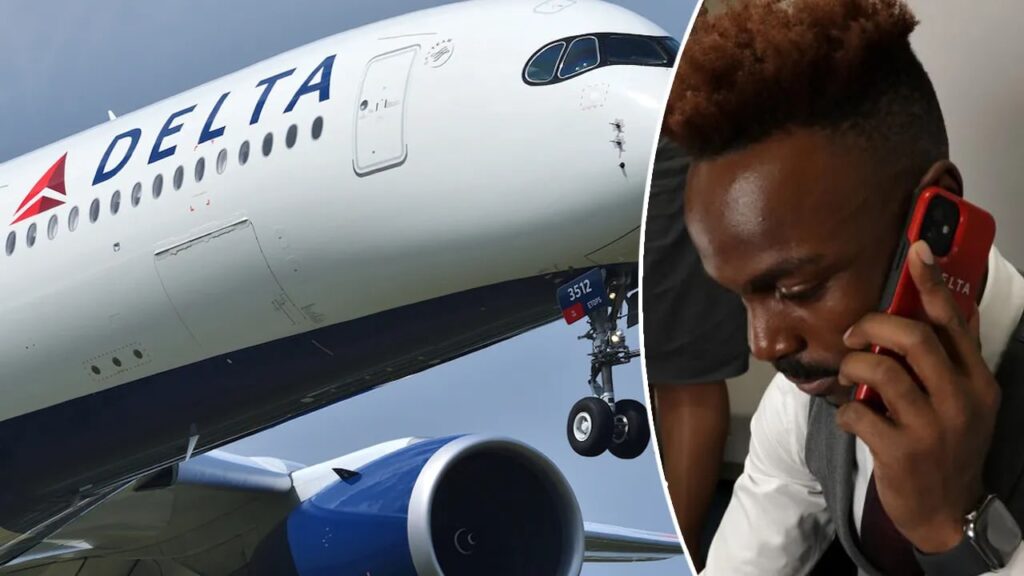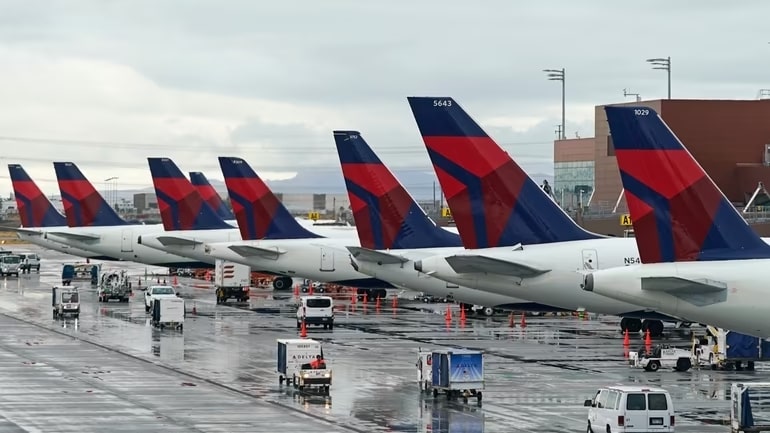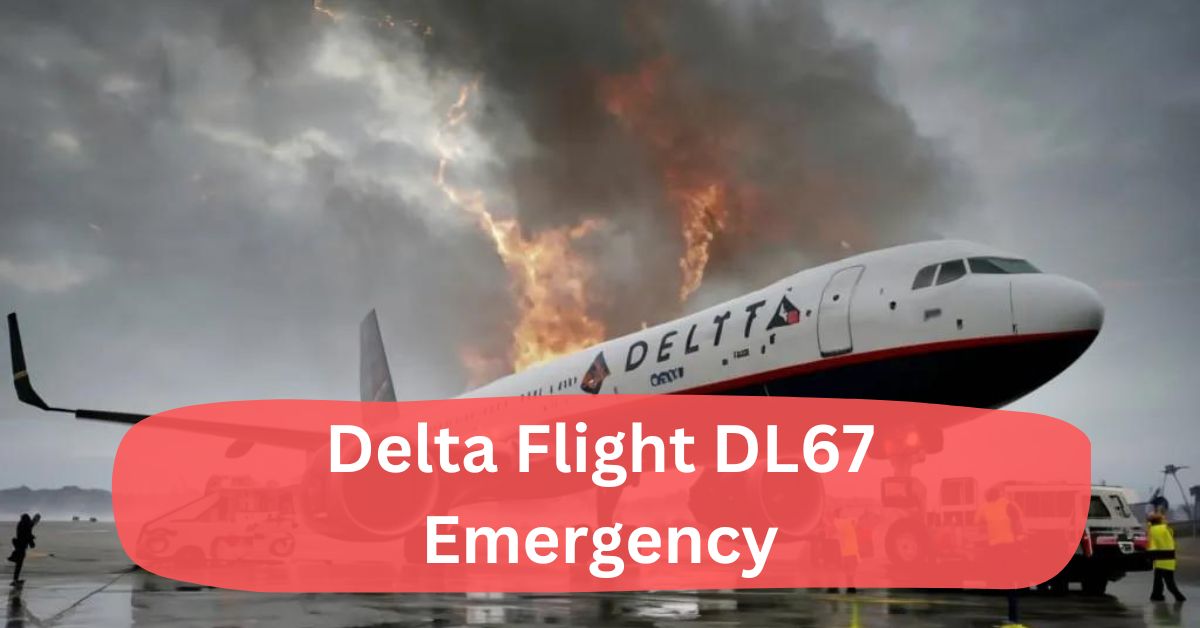On April 11, 2024, Delta flight DL67 emergency became a significant event in the aviation industry. The Atlanta-bound flight, which had originally departed from Rome, Italy, was forced to divert to Charles de Gaulle Airport in Paris, France, due to a medical emergency. This article delves into the details of the incident, how it unfolded, and the steps taken by the flight crew to ensure passenger safety.
Overview of Delta Flight DL67:
Delta flight DL67 was operating on a scheduled route from Rome, Italy, to Atlanta, Georgia, on April 11. However, a medical emergency onboard forced the flight crew to declare a general emergency. The Delta flight DL67 emergency was called at approximately 33,000 feet while flying over Western France.
1. The Cause of the Delta Flight DL67 Emergency:
Reports indicated that the Delta flight DL67 emergency stemmed from a medical issue involving one of the passengers. While the nature of the medical condition has not been disclosed, it was severe enough for the flight crew to make the critical decision to divert from the planned route.
2. The Emergency Declaration:
Upon realizing the severity of the situation, the crew promptly declared a Delta flight DL67 emergency. The declaration of a general emergency is a procedure in which the crew communicates with air traffic control (ATC) to inform them of the situation, allowing the flight to prioritize landing at the nearest available airport.
3. Diversion to Charles de Gaulle Airport:
Due to the Delta flight DL67 emergency, the flight was diverted to Charles de Gaulle Airport in Paris, France, as it was the nearest major airport with the necessary medical facilities. The diversion was carried out smoothly, and the plane landed without further incident.
4. Crew Response to Delta Flight DL67 Emergency:
The professionalism of the Delta Airlines crew during the Delta flight DL67 emergency played a pivotal role in ensuring the safety of the passengers. They acted swiftly to address the medical situation, keeping passengers informed while following established protocols for emergencies.
5. Impact on Passengers:
Although the Delta flight DL67 emergency caused an unscheduled landing in Paris, passengers remained calm throughout the ordeal. Medical personnel were already on standby upon landing, ready to assist the passenger in need. Other passengers were accommodated while waiting for the situation to be resolved.
Emergency Procedures During Delta Flight DL67:
The Delta flight DL67 emergency serves as an example of how quickly situations can escalate in the air and the importance of having trained personnel onboard. Delta Airlines, like all major airlines, follows strict emergency procedures to protect the lives of its passengers.
1. Communication with Air Traffic Control:
During the Delta flight DL67 emergency, communication with air traffic control was crucial. The crew alerted ATC of the general emergency, which allowed the flight to be prioritized for landing. ATC also assisted the crew by directing them to the nearest suitable airport, which in this case, was Charles de Gaulle.
2. Passenger Safety During Delta Flight DL67 Emergency:
In cases like the Delta flight DL67 emergency, passenger safety remains the top priority. The flight crew ensured that everyone was briefed on the situation and remained seated with their seatbelts fastened. Medical assistance was provided to the affected passenger as much as possible during the flight.
How Delta Airlines Handles Emergencies?

Delta Airlines is known for its high safety standards and strict protocols when dealing with emergencies like the Delta flight DL67 emergency. The airline ensures that its crew is highly trained to handle a wide range of scenarios, from medical issues to technical problems.
1. Medical Assistance on Board:
In the case of the Delta flight DL67 emergency, it is likely that the onboard medical kit and equipment were used to assist the passenger in distress. The flight attendants and any medical personnel on the plane would have worked together to stabilize the situation before the plane could safely land.
2. Diverting a Flight: What It Entails:
When the Delta flight DL67 emergency was declared, diverting the flight to a closer airport was the best course of action. This process involves not only rerouting the plane but also coordinating with airport staff to ensure that medical help is available upon landing. The flight crew’s timely decision to divert to Paris likely saved valuable time in treating the passenger.
Medical Protocols and Equipment on Delta Flight DL67:
During the Delta flight DL67 emergency, the aircraft’s onboard medical kit and equipment were crucial in providing immediate assistance. Airlines like Delta equip their planes with emergency medical kits containing various supplies, including medications, first aid items, and medical devices.
These kits are designed to address a range of medical issues that may arise during the flight. For the Delta flight DL67 emergency, the crew would have used these resources to stabilize the affected passenger until the plane could land.
Additionally, flight attendants trained in first aid and CPR would have worked alongside any medical professionals onboard to manage the situation effectively.
Coordination with Ground Services During the Emergency:
When Delta flight DL67 declared an emergency, coordination with ground services at Charles de Gaulle Airport became a critical part of the response. Before landing, the flight crew communicated with airport authorities to ensure that medical personnel were ready and waiting upon arrival.
This coordination involved informing ground services about the nature of the emergency so that appropriate medical teams could be mobilized and stationed at the gate. This proactive approach ensured that the passenger in need received prompt medical care as soon as the plane touched down, minimizing any potential delays in treatment.
Impact on Subsequent Flights and Operations:
The diversion of Delta flight DL67 had ripple effects on Delta Airlines’ operations and other flights. When a plane diverts due to an emergency, it can affect the scheduling and availability of aircraft and crew for subsequent flights. Delta Airlines would have needed to adjust its flight schedules and manage any delays or cancellations resulting from the diversion.
Additionally, passengers on other flights might have experienced changes in their itineraries as the airline worked to accommodate the unexpected circumstances caused by the Delta flight DL67 emergency. Such operational adjustments are part of the broader logistical challenges airlines face when handling in-flight emergencies.
Psychological Impact on Passengers and Crew:
The Delta flight DL67 emergency would have also had a psychological impact on both passengers and crew. For the passengers, witnessing or being involved in an emergency situation can be stressful and unsettling.
The flight crew, on the other hand, undergoes rigorous training to manage such situations, but they too may experience stress and emotional strain. Delta Airlines provides support to its crew members following such incidents, offering counseling and debriefing sessions to help them process their experiences.
Addressing the emotional well-being of all individuals involved is an essential part of managing the aftermath of emergencies like the Delta flight DL67 emergency.
Post-Incident Investigation and Reporting:
Following the Delta flight DL67 emergency, an investigation would have been conducted to understand the full scope of the incident and ensure that all protocols were followed correctly. The investigation typically involves reviewing the flight data, crew reports, and medical records related to the emergency.

Aviation authorities, such as the National Transportation Safety Board (NTSB) or the European Union Aviation Safety Agency (EASA), may also be involved in assessing the circumstances surrounding the emergency.
This thorough review helps to identify any potential areas for improvement in emergency procedures and ensures that similar situations are managed more effectively in the future.
Passenger Reaccommodation and Compensation:
The diversion of Delta flight DL67 likely affected passengers’ travel plans, requiring Delta Airlines to manage reaccommodation and compensation. After the emergency landing, passengers would have been provided with alternative flight options or accommodations to reach their final destinations.
Delta Airlines typically offers assistance such as meal vouchers, hotel stays, and transportation for affected passengers. Additionally, compensation may be provided depending on the length of the delay and the nature of the inconvenience caused. The airline’s customer service team would work to address individual passenger needs and concerns arising from the disruption.
Communication Strategy During the Delta Flight DL67 Emergency:
Effective communication is vital during emergencies like the Delta flight DL67 emergency. Delta Airlines would have employed a strategic communication plan to keep all stakeholders informed. This includes informing passengers about the situation, addressing their concerns, and providing updates on the status of the flight.
For family members of those onboard, Delta would have set up channels to offer information and reassurance. Additionally, media relations teams would have been involved in managing public information and addressing any inquiries from the press. Clear and transparent communication helps to maintain trust and manage expectations during such high-pressure situations.
Long-Term Implications for Airline Safety and Training:
The Delta flight DL67 emergency underscores the importance of continuous improvement in airline safety and crew training. Following the incident, Delta Airlines would review and possibly enhance its emergency response protocols and training programs. This may include updating training materials, conducting additional simulations, and reinforcing procedures for managing medical emergencies.
The airline’s safety culture is strengthened by analyzing real-life emergencies and incorporating lessons learned into future training and operational practices. By doing so, Delta aims to ensure that its crew is better prepared for similar situations, ultimately contributing to higher safety standards and improved passenger confidence.
FAQs About Delta Flight DL67 Emergency:
1. What Caused The Delta Flight Dl67 Emergency?
The Delta flight DL67 emergency was caused by a medical emergency involving a passenger onboard.
2. Where Did Delta Flight Dl67 Land After The Emergency?
Following the Delta flight DL67 emergency, the flight was diverted to Charles de Gaulle Airport in Paris, France.
3. How Did The Crew Respond To The Delta Flight Dl67 Emergency?
The crew declared a general emergency and diverted the flight to ensure the affected passenger received medical attention.
4. Was Anyone Injured During The Delta Flight Dl67 Emergency?
There were no reports of additional injuries during the Delta flight DL67 emergency. The focus was on assisting the passenger with the medical issue.
5. How Does Delta Airlines Handle Emergencies Like Delta Flight Dl67?
Delta Airlines follows strict safety protocols, ensuring that its crew is trained to handle emergencies like the Delta flight DL67 emergency efficiently.
6. Is It Common For Flights To Be Diverted Due To Medical Emergencies?
While not common, medical emergencies can occur, as seen in the Delta flight DL67 emergency, prompting flights to divert for the safety of passengers.
Conclusion: Lessons from Delta Flight DL67 Emergency
The Delta flight DL67 emergency highlighted the importance of quick decision-making, thorough training, and coordination between the flight crew and air traffic control. While unexpected emergencies like these can disrupt travel plans, they also demonstrate the effectiveness of the systems in place to handle such situations.
The Delta flight DL67 emergency was a reminder of the unpredictable nature of air travel and the critical role of trained professionals in ensuring safety. Delta Airlines’ handling of the situation reflects its commitment to passenger care and safety, ensuring that all necessary measures are taken in the face of emergencies.
